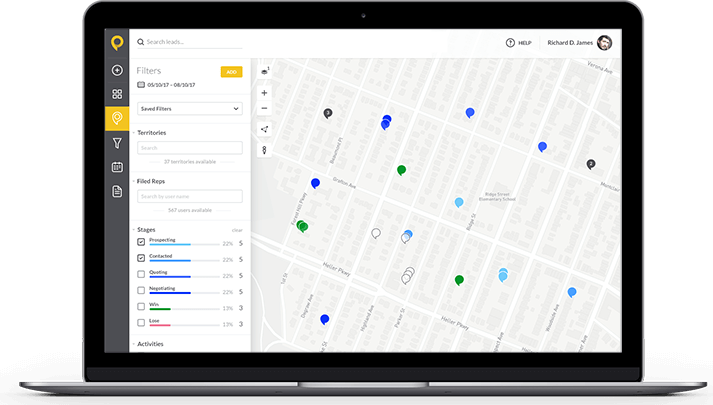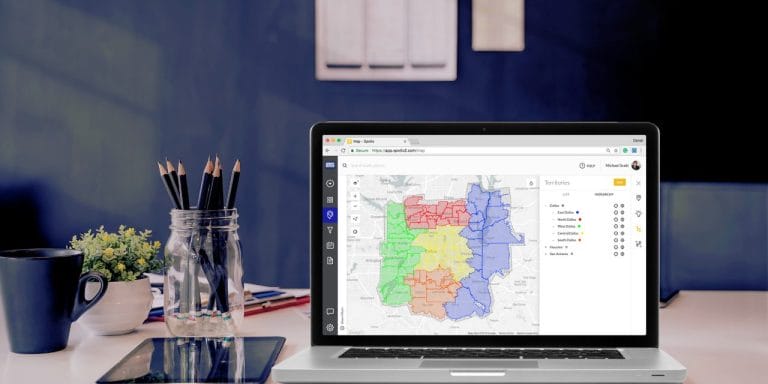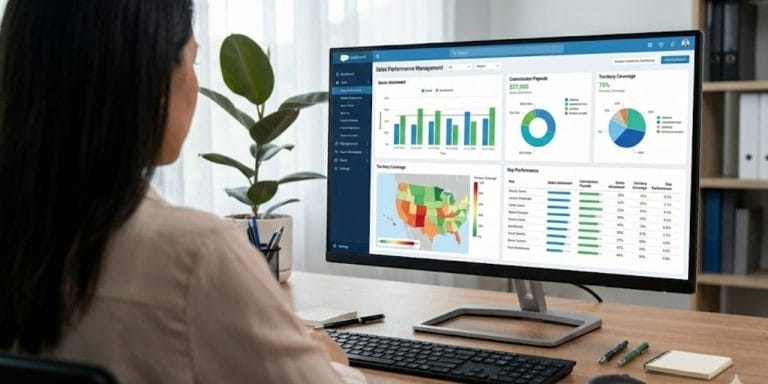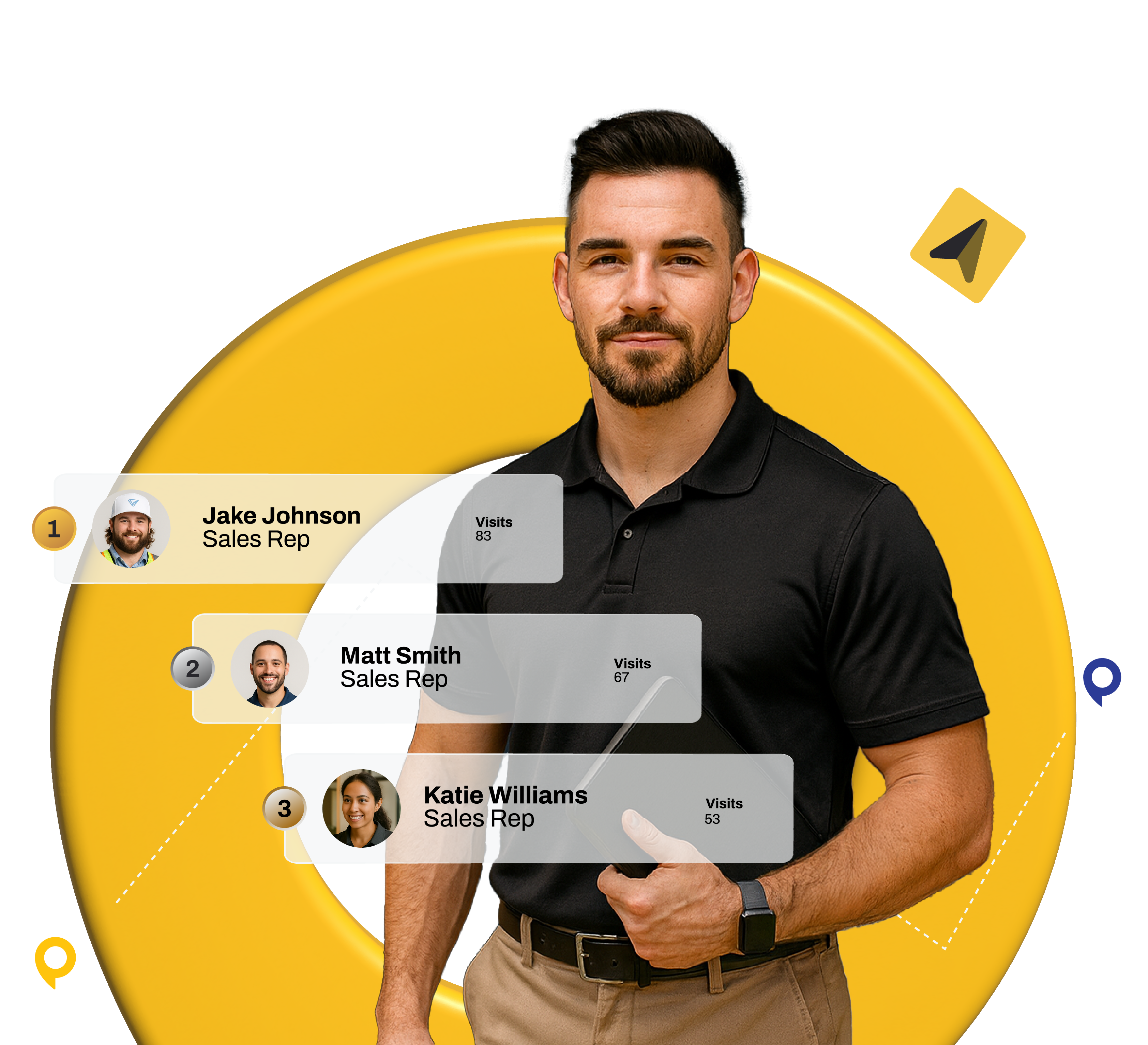Sales optimization is an ongoing process of refining every element of how you sell. By setting measurable goals, understanding your ideal customers, aligning team efforts, managing territories strategically, and using the right tools, you can streamline your pipeline, improve communication, and make data-driven decisions. Over time, this systematic approach turns continuous improvement into a powerful engine for long-term revenue growth.
In this post, we’ll clarify what sales optimization really means and share proven best practices you can apply now. Armed with these insights, you’ll be ready to strengthen your team’s performance and achieve lasting results.
Table of contents
- What is Sales Optimization?
- 10 Sales Optimization Strategies
- 1. Establish Measurable Sales Goals
- 2. Build an Ideal Customer Profile
- 3. Track and Analyze Sales Data
- 4. Review Digital Marketing Efforts
- 5. Spot Holes in the Pipeline
- 6. Align Sales and Marketing Teams
- 7. Strategically Assign Territories
- 8. Nurture and Manage Leads Effectively
- 9. Monitor and Provide Continuous Feedback
- 10. Eliminate Tedious Tasks
- Build a Winning Sales Optimization Toolset
- How Are You Going to Optimize Your Sales Process?
What is Sales Optimization?
Sales optimization is the disciplined effort to enhance every aspect of your sales process. It involves analyzing past outcomes to identify effective tactics, coaching team members to improve their selling techniques, and establishing sales incentives that support consistent progress. It also means refining outreach strategies, sharpening your messaging, and using data-driven insights to ensure you meet your revenue targets.
10 Sales Optimization Strategies
In the sections that follow, we’ll outline 10 practical steps to boost your sales performance. These include setting measurable goals, defining your ideal customers, aligning sales and marketing, refining your pipeline management, and using automation to streamline routine tasks. With these strategies in place, you’ll build a stronger, more efficient sales operation that supports sustainable growth.
1. Establish Measurable Sales Goals
Every sales team wants to grow revenue. But to do that, you need to define specific, measurable steps that support that goal. For example, instead of “Grow YOY revenue by 25%,” you could instead assign your sales team tasks like:
- Talk to five new prospects each week
- Follow up with cold leads every two weeks
- Close three new deals per quarter
Specific tasks based on concrete numbers or timeframes help sales representatives stay focused and ensure everyone is doing their part to support broader business goals. That’s key for sales optimization.
2. Build an Ideal Customer Profile
Building an ideal customer profile (ICP) or buyer persona helps you focus on the right type of prospect. An ICP also helps you target customers at every stage of the buyer’s journey.
Buyer personas include behaviors and characteristics such as:
- Preferred communication channels
- Buying patterns
- Motivation to purchase services and products
- Feelings and emotions that will trigger them to buy
- Common objections (and how to handle them)
While a buyer persona is a fictional characterization of your ideal customer, it helps to put a face to the details, like this example of “Facility Manager Fred”:
To get started with buyer personas, take a look at your existing customer data. Identify the common qualities among your key accounts, and include those qualities in your persona documentation. You can also gain valuable insights from analyzing customer churn. When you understand why customers were a poor fit for your product, you can create a “negative persona” that excludes people from your prospecting process based on churn risk factors.

Tip: Use SPOTIO’s Sales Intelligence tool to quickly create an ICP for B2B or B2C prospecting. You can select from over 200 data points like income, credit capacity, annual revenue, and job title, and filter prospects by sales territory.
3. Track and Analyze Sales Data
If you’re going to optimize your sales processes, you need an effective way to track and analyze sales data and KPIs like number of sales calls per team member, close rate, and average customer account value. SPOTIO makes it easy to see who’s closing deals, who your sales leaders are, and where leads are in the sales cycle.
Keep in mind that sales data analytics aren’t just for managers. You can allow sales teams to see individual sales metrics, how other team members are managing their sales pipeline, and how your sales strategy is working. This transparency can encourage healthy competition among teams.
 Image: SPOTIO sales tracking software.
Image: SPOTIO sales tracking software.
4. Review Digital Marketing Efforts
Because online research is a big part of the customer journey, you need to review how you’re tracking digital engagement. At a minimum, your sales optimization process should include these tasks:
- Set up web traffic analysis – Use Google Analytics to track visitors to your website and analyze customer interactions. Check which pages get the most views and leads. Conversely, check underperforming pages to see what can be improved. You can also track the most successful sources of traffic, to see where your visitors are coming from.
- Set up campaign tracking – Use Google’s URL Builder tool to add campaign parameters to URLs so you can track Custom Campaigns in Google Analytics.
Add your website URL, the campaign source, medium, and name to generate a campaign URL:
Here’s the campaign URL based on the inputs above: https://www.example.com/?utm_source=newsletter&utm_medium=email&utm_campaign=spring_sale
You can use your campaign URL in any promotional channels, and see campaign metrics in Google Analytics.
5. Spot Holes in the Pipeline
Sluggish sales can happen for a number of reasons and at any point in the sales cycle — in prospecting, nurturing, or in the proposal stage. It’s important to review your sales processes regularly so you can spot any weak points in the sales pipeline.
For example, if your average sales cycle is 200 days, and your conversion rate is 10%, your sales funnel should look like this, if you want to close 20 deals:
- SQLs – 200 prospects
- Value proposition stage – 140 leads
- Proposal/price quote – 100 leads
- Negotiation/review – 50 potential customers
If your numbers are off-track, you’ll need to review your sales data to solve the problem, and adjust your sales process.
Tip: Use SPOTIO’s Pipeline Management feature for data-driven insights about your sales process. Outside sales teams can use SPOTIO as a standalone CRM (although it’s not technically a CRM). You can also connect SPOTIO to a CRM like Salesforce to sync all marketing and sales data throughout the sales journey.

6. Align Sales and Marketing Teams
Although sales and marketing teams have similar goals to boost revenue and drive growth, they often struggle to work together effectively. According to a report from Marketo, salespeople ignore 50% of marketing leads. Getting your marketing team and sales staff on the same page is critical for your overall sales strategy.
MarketingProfs found that organizations with tightly aligned sales and marketing teams experience 36% higher customer retention rates and 38% higher sales win rates.
Here are three ways to align your marketing and sales team:
- Share funnels – Create one funnel, so each team knows what the other is doing.
- Share accountability – Create joint goals and objectives, so both teams are accountable for results and have to perform to a high level.
- Share planning – Create strategic and operational plans together, and hold regular review meetings.
By working together, marketing teams can provide the right type of content and qualified leads that enables sales teams to retain and win more customers.
7. Strategically Assign Territories
Sales managers should define sales territories to prevent overlap and miscommunication among sales team members. With clear territory boundaries to support your sales optimization process, everyone knows where to focus their sales efforts, and sales representatives can build stronger localized connections.
Tip: Use SPOTIO’s Territory Manager to create digital color-coded maps, compare sales performance by territory, and create territory hierarchies with custom permissions. SPOTIO also helps you find opportunities for improvement — like territories that require too much drive time because of the distance between prospects — and easily reconfigure territories.

8. Nurture and Manage Leads Effectively
Nurturing and managing leads is an essential step in the sales optimization process. But determining the right cadence for contacting leads is a difficult part of the sales process. If you move too quickly, you can alienate prospects, but if you wait too long, you might lose a lead.
Here are three things to avoid when nurturing new leads:
- Don’t contact the prospect too early
- Don’t focus only on selling – focus on prospects’ pain points
- Don’t neglect your existing prospects
Sales reps tend to give up on reaching a prospect after three or four unsuccessful attempts. But research shows that on average, it takes around eight interactions with prospects to get their attention. That’s why it’s important to develop relationships based on prospect pain points and build trust that can lead to conversion.
There are numerous benefits to building customer relationships. Even when prospects don’t convert, they might recommend you to their peers or reach back out when they’re in a better position to move forward. Sales optimization strategies require short-term action, as well as long-term vision.
9. Monitor and Provide Continuous Feedback
If you want your sales process to be effective you need to identify, track, and measure the right data. Salespeople need to know the KPIs they’re working toward, and you need to provide continuous feedback on their progress.
Use metrics that improve sales performance rather than vanity metrics. HBR lists 12 sales metrics that matter most for sales optimization. Remove any erroneous, outdated or irrelevant data so that metrics are accurate and salespeople are not distracted.
10. Eliminate Tedious Tasks
According to HubSpot: “Over 20% of sales professionals cited manual data entry as their top CRM challenge. Other issues included lack of integration with other tools and invalid or incorrect data.”
Obviously, you want your sales team to focus on sales, not data entry. Look for sales automation tools that can eliminate manual tasks in the sales process. Some sales software — like SPOTIO — automates every step in the sales process, reminding your reps when to follow-up with prospects and automatically logging every interaction.
Build a Winning Sales Optimization Toolset
Sales software helps organizations improve their sales processes and generate more revenue.
With relevant sales data stored in a single database, the software lets you manage your sales pipeline, track leads and contact information, plus streamline and automate workflows.
Despite the increase in revenue, 34% of the salespeople interviewed aren’t using software for sales process optimization. Either because they prefer traditional sales methods or because their company has not invested in software to optimize their sales process.
Here are four ways your outside sales teams could benefit from using sales optimization software:
Prospecting
SPOTIO sales intelligence software includes Lead Machine, which empowers sales teams to work more effectively and close more sales by targeting the best leads within a chosen territory.
Because Lead Machine offers 200 unique data points (including age, credit score, home or business type, etc.) to target your ideal customer in any given area, you can generate qualified leads for your door-to-door sales team in seconds.

Territory Management
Maximizing contact rate is the number one step in gaining sales efficiency. Using SPOTIO’s territory management software to create strategic territories related to your target market means your sales reps spend more time in the field engaging in face-to-face meetings. So their contact rate is maximized, and as a result, sales increase.
You can create territories based on ZIP Codes or by selecting a few streets in a neighborhood. And then assign territories strategically to individual sales reps:
Lead Management
SPOTIO’s lead management software helps your team focus on the right sales activities in the field. For example, sales reps can ignore the “Not Interested” leads (until it’s time to follow-up) and focus on the red hot “Future” leads.
The software assigns a “stage” to each lead based on your company’s sales process and the data you want to track. You can also identify prospects by a color mapped to your sales funnel.
Sales reps can access and use this real-time “lead intelligence” out in the field as they interact with prospects to close more sales.
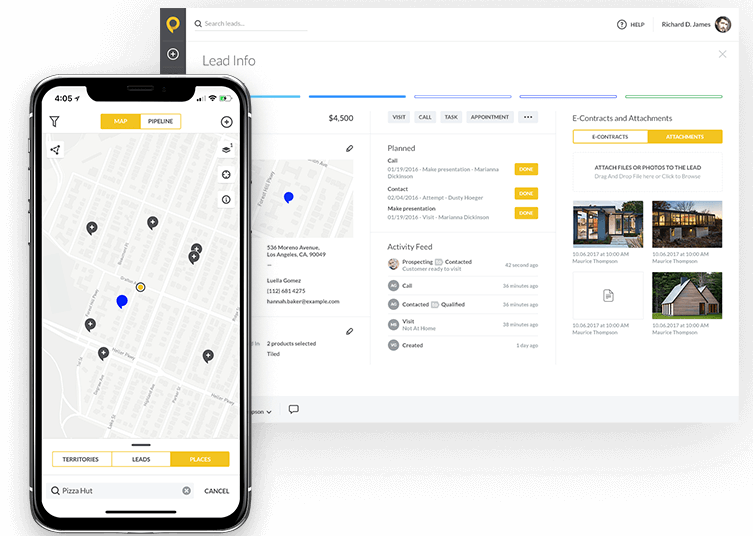
Tracking and Reporting
The rep tracking software from SPOTIO monitors the performance and location of your sales reps:
Are your reps actually out in the field? Are they visiting the right locations? Are they where they say they are?
With SPOTIO you can see where your reps are and check the results of their customer interactions.
The location verification tool tags each reps’ location as “pins” are dropped, and then classified in one of two ways:
- Verified = sales rep tracked within a 300-foot (100-yard) radius of the address of a dropped pin.
- Unverified = sales rep not tracked within the 300-foot radius of the address they claimed to have dropped the pin.
Rep tracking takes accountability to a new level.
SPOTIO’s sales tracking software gives you real-time visibility of your team’s performance. From the dashboard you can see:
- Team leaderboards – Measure the performance of individual sales reps, teams, or your entire field sales organization.
- Executive insights – Discover the best times to prospect, best performing territories, etc. to maximize team efficiency.
- CRM integrations – Automate and streamline your sales process further with integrations to more than 750 different apps, services, and software.
It also helps with the continuous improvement assessments of individuals as you can measure performance in relation to your sales funnel and map data from custom statuses and fields based on KPIs.
How Are You Going to Optimize Your Sales Process?
Optimizing your sales process is not a quick one-time fix. Sales optimization is an ongoing project.
Successful sales teams evaluate and refine their processes continuously to achieve long-term growth. And, where applicable, they invest in new technologies to help streamline their sales process and boost revenue.
What are you planning to optimize first?
_____
Questions or comments? Contact SPOTIO at [email protected] or comment below.
SPOTIO is the #1 field sales automation and performance management software that will increase revenue, maximize profitability, and boost sales productivity.
Want to see a product demonstration? Click here to see how SPOTIO can take your sales game to the next level.

